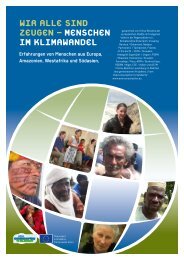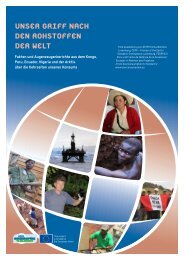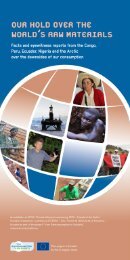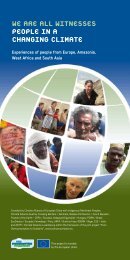THE LAND WE GRAB
You also want an ePaper? Increase the reach of your titles
YUMPU automatically turns print PDFs into web optimized ePapers that Google loves.
Brazil 1<br />
The Amazon,<br />
anindigenous<br />
cultural<br />
landscape<br />
Abadio Green<br />
of the Tule people in Colombia<br />
Settlement and<br />
plantations of<br />
indigenous peoples<br />
living in voluntary<br />
isolation<br />
© Grupo Sal<br />
© Miranda Gleilson, AG Noticias<br />
Abadio Green: "We see nature as<br />
our mother, who cares for us. It is<br />
even more important than our own<br />
mother, because she will leave<br />
us at some point in our lives. But<br />
Mother Earth will always be there<br />
and even takes us into herself<br />
after our death. Everything we own<br />
and consume in our world but also<br />
in the Western world ultimately<br />
comes from the earth."<br />
<strong>THE</strong> AMAZON IS NOT A "JUNGLE"<br />
The idea that the Amazon rainforest is an intact ecological habitat, because it<br />
was largely spared from people, is increasingly called into question by recent<br />
fi nding s :<br />
• Archaeological evidence showing that the Amazon has been inhabited for over<br />
10,000 years.<br />
• Investigations of fertile soil that shouldn't occur naturally and that were<br />
demonstrably created by man, the Terra Preta, or black earth - a mixture of<br />
organic residues and charcoal that binds the scarce nutrients in the soil for<br />
long periods of time.<br />
• Anthropological insights about today's peoples - the Kayapo, for example,<br />
have designed their environment, according to their needs, in their little<br />
gardens they grow foods such as cassava and maize for daily consumption,<br />
and on paths between the villages other food and medicinal plants are<br />
cultivated. Similarly, the Baniwa in Rio Negro, beside 53 km of trails between<br />
7 villages, 325 gardens exist with food and medicinal plants.<br />
More and more facts indicate that large parts of the Amazon should be regarded<br />
as an "indigenous cultural landscape" that was fashioned out of a natural<br />
ecosystem, through deliberate human intervention, over many millennia. This<br />
way of life is closely connected with the cosmic vision of indigenous peoples, in<br />
which animals, plants and humans are equal and animated, and allows for the<br />
sustainable use of the ecosystem without destroying it.<br />
Deforestation up to 2007 (red and yellow dots): Where the indigenous have land rights, as for<br />
example in the Upper Xingu, the rainforest has been preserved.<br />
Further information at: www.overconsumption.eu









